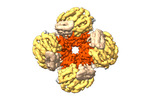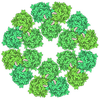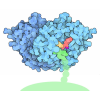[English] 日本語
 Yorodumi
Yorodumi- EMDB-16357: CryoEM structure of Aspergillus nidulans UTP-glucose-1-phosphate ... -
+ Open data
Open data
- Basic information
Basic information
| Entry |  | |||||||||
|---|---|---|---|---|---|---|---|---|---|---|
| Title | CryoEM structure of Aspergillus nidulans UTP-glucose-1-phosphate uridylyltransferase | |||||||||
 Map data Map data | Main sharpened cryoEM map with D4 symmetry | |||||||||
 Sample Sample |
| |||||||||
 Keywords Keywords | NDP-sugar pyrophosphorylases / UDP-Glc pyrophosphorylases / cell wall biosynthesis / Aspergillus nidulans. / SUGAR BINDING PROTEIN | |||||||||
| Function / homology |  Function and homology information Function and homology information(1->6)-beta-D-glucan biosynthetic process / UTP-glucose-1-phosphate uridylyltransferase / UTP:glucose-1-phosphate uridylyltransferase activity / trehalose biosynthetic process / UDP-alpha-D-glucose metabolic process / glycogen biosynthetic process / glycogen metabolic process / cytoplasm Similarity search - Function | |||||||||
| Biological species |  | |||||||||
| Method | single particle reconstruction / cryo EM / Resolution: 3.98 Å | |||||||||
 Authors Authors | Han X / D Angelo C / Otamendi A / Cifuente JO / de Astigarraga E / Ochoa-Lizarralde B / Grininger M / Routier FH / Guerin ME / Fuehring J ...Han X / D Angelo C / Otamendi A / Cifuente JO / de Astigarraga E / Ochoa-Lizarralde B / Grininger M / Routier FH / Guerin ME / Fuehring J / Etxebeste O / Connell SR | |||||||||
| Funding support |  Spain, 1 items Spain, 1 items
| |||||||||
 Citation Citation |  Journal: mBio / Year: 2023 Journal: mBio / Year: 2023Title: CryoEM analysis of the essential native UDP-glucose pyrophosphorylase from reveals key conformations for activity regulation and function. Authors: Xu Han / Cecilia D'Angelo / Ainara Otamendi / Javier O Cifuente / Elisa de Astigarraga / Borja Ochoa-Lizarralde / Martin Grininger / Francoise H Routier / Marcelo E Guerin / Jana Fuehring / ...Authors: Xu Han / Cecilia D'Angelo / Ainara Otamendi / Javier O Cifuente / Elisa de Astigarraga / Borja Ochoa-Lizarralde / Martin Grininger / Francoise H Routier / Marcelo E Guerin / Jana Fuehring / Oier Etxebeste / Sean R Connell /   Abstract: Invasive aspergillosis is one of the most serious clinical invasive fungal infections, resulting in a high case fatality rate among immunocompromised patients. The disease is caused by saprophytic ...Invasive aspergillosis is one of the most serious clinical invasive fungal infections, resulting in a high case fatality rate among immunocompromised patients. The disease is caused by saprophytic molds in the genus , including , the most significant pathogenic species. The fungal cell wall, an essential structure mainly composed of glucan, chitin, galactomannan, and galactosaminogalactan, represents an important target for the development of antifungal drugs. UDP (uridine diphosphate)-glucose pyrophosphorylase (UGP) is a central enzyme in the metabolism of carbohydrates that catalyzes the biosynthesis of UDP-glucose, a key precursor of fungal cell wall polysaccharides. Here, we demonstrate that the function of UGP is vital for (UGP). To understand the molecular basis of UGP function, we describe a cryoEM structure (global resolution of 3.5 Å for the locally refined subunit and 4 Å for the octameric complex) of a native UGP. The structure reveals an octameric architecture with each subunit comprising an N-terminal α-helical domain, a central catalytic glycosyltransferase A-like (GT-A-like) domain, and a C-terminal (CT) left-handed β-helix oligomerization domain. UGP displays unprecedented conformational variability between the CT oligomerization domain and the central GT-A-like catalytic domain. In combination with activity measurements and bioinformatics analysis, we unveil the molecular mechanism of substrate recognition and specificity for UGP. Altogether, our study not only contributes to understanding the molecular mechanism of catalysis/regulation of an important class of enzymes but also provides the genetic, biochemical, and structural groundwork for the future exploitation of UGP as a potential antifungal target. IMPORTANCE Fungi cause diverse diseases in humans, ranging from allergic syndromes to life-threatening invasive diseases, together affecting more than a billion people worldwide. Increasing drug resistance in species represents an emerging global health threat, making the design of antifungals with novel mechanisms of action a worldwide priority. The cryoEM structure of UDP (uridine diphosphate)-glucose pyrophosphorylase (UGP) from the filamentous fungus reveals an octameric architecture displaying unprecedented conformational variability between the C-terminal oligomerization domain and the central glycosyltransferase A-like catalytic domain in the individual protomers. While the active site and oligomerization interfaces are more highly conserved, these dynamic interfaces include motifs restricted to specific clades of filamentous fungi. Functional study of these motifs could lead to the definition of new targets for antifungals inhibiting UGP activity and, thus, the architecture of the cell wall of filamentous fungal pathogens. | |||||||||
| History |
|
- Structure visualization
Structure visualization
| Supplemental images |
|---|
- Downloads & links
Downloads & links
-EMDB archive
| Map data |  emd_16357.map.gz emd_16357.map.gz | 57.2 MB |  EMDB map data format EMDB map data format | |
|---|---|---|---|---|
| Header (meta data) |  emd-16357-v30.xml emd-16357-v30.xml emd-16357.xml emd-16357.xml | 26.1 KB 26.1 KB | Display Display |  EMDB header EMDB header |
| FSC (resolution estimation) |  emd_16357_fsc.xml emd_16357_fsc.xml | 8.5 KB | Display |  FSC data file FSC data file |
| Images |  emd_16357.png emd_16357.png | 72.9 KB | ||
| Filedesc metadata |  emd-16357.cif.gz emd-16357.cif.gz | 6.1 KB | ||
| Others |  emd_16357_additional_1.map.gz emd_16357_additional_1.map.gz emd_16357_additional_2.map.gz emd_16357_additional_2.map.gz emd_16357_additional_3.map.gz emd_16357_additional_3.map.gz emd_16357_additional_4.map.gz emd_16357_additional_4.map.gz emd_16357_additional_5.map.gz emd_16357_additional_5.map.gz emd_16357_half_map_1.map.gz emd_16357_half_map_1.map.gz emd_16357_half_map_2.map.gz emd_16357_half_map_2.map.gz | 31.1 MB 31.6 MB 57.4 MB 32.2 MB 57.2 MB 59.1 MB 59.1 MB | ||
| Archive directory |  http://ftp.pdbj.org/pub/emdb/structures/EMD-16357 http://ftp.pdbj.org/pub/emdb/structures/EMD-16357 ftp://ftp.pdbj.org/pub/emdb/structures/EMD-16357 ftp://ftp.pdbj.org/pub/emdb/structures/EMD-16357 | HTTPS FTP |
-Validation report
| Summary document |  emd_16357_validation.pdf.gz emd_16357_validation.pdf.gz | 724.1 KB | Display |  EMDB validaton report EMDB validaton report |
|---|---|---|---|---|
| Full document |  emd_16357_full_validation.pdf.gz emd_16357_full_validation.pdf.gz | 723.6 KB | Display | |
| Data in XML |  emd_16357_validation.xml.gz emd_16357_validation.xml.gz | 16.4 KB | Display | |
| Data in CIF |  emd_16357_validation.cif.gz emd_16357_validation.cif.gz | 21.3 KB | Display | |
| Arichive directory |  https://ftp.pdbj.org/pub/emdb/validation_reports/EMD-16357 https://ftp.pdbj.org/pub/emdb/validation_reports/EMD-16357 ftp://ftp.pdbj.org/pub/emdb/validation_reports/EMD-16357 ftp://ftp.pdbj.org/pub/emdb/validation_reports/EMD-16357 | HTTPS FTP |
-Related structure data
| Related structure data |  8c0bMC M: atomic model generated by this map C: citing same article ( |
|---|---|
| Similar structure data | Similarity search - Function & homology  F&H Search F&H Search |
- Links
Links
| EMDB pages |  EMDB (EBI/PDBe) / EMDB (EBI/PDBe) /  EMDataResource EMDataResource |
|---|---|
| Related items in Molecule of the Month |
- Map
Map
| File |  Download / File: emd_16357.map.gz / Format: CCP4 / Size: 64 MB / Type: IMAGE STORED AS FLOATING POINT NUMBER (4 BYTES) Download / File: emd_16357.map.gz / Format: CCP4 / Size: 64 MB / Type: IMAGE STORED AS FLOATING POINT NUMBER (4 BYTES) | ||||||||||||||||||||||||||||||||||||
|---|---|---|---|---|---|---|---|---|---|---|---|---|---|---|---|---|---|---|---|---|---|---|---|---|---|---|---|---|---|---|---|---|---|---|---|---|---|
| Annotation | Main sharpened cryoEM map with D4 symmetry | ||||||||||||||||||||||||||||||||||||
| Projections & slices | Image control
Images are generated by Spider. | ||||||||||||||||||||||||||||||||||||
| Voxel size | X=Y=Z: 1.09 Å | ||||||||||||||||||||||||||||||||||||
| Density |
| ||||||||||||||||||||||||||||||||||||
| Symmetry | Space group: 1 | ||||||||||||||||||||||||||||||||||||
| Details | EMDB XML:
|
-Supplemental data
-Additional map: Main unsharpened cryoEM map with D4 symmetry
| File | emd_16357_additional_1.map | ||||||||||||
|---|---|---|---|---|---|---|---|---|---|---|---|---|---|
| Annotation | Main unsharpened cryoEM map with D4 symmetry | ||||||||||||
| Projections & Slices |
| ||||||||||||
| Density Histograms |
-Additional map: unsharpened cryoEM map with C1 symmetry
| File | emd_16357_additional_2.map | ||||||||||||
|---|---|---|---|---|---|---|---|---|---|---|---|---|---|
| Annotation | unsharpened cryoEM map with C1 symmetry | ||||||||||||
| Projections & Slices |
| ||||||||||||
| Density Histograms |
-Additional map: sharpened cryoEM map with C1 symmetry
| File | emd_16357_additional_3.map | ||||||||||||
|---|---|---|---|---|---|---|---|---|---|---|---|---|---|
| Annotation | sharpened cryoEM map with C1 symmetry | ||||||||||||
| Projections & Slices |
| ||||||||||||
| Density Histograms |
-Additional map: unsharpened locally refined cryoEM map
| File | emd_16357_additional_4.map | ||||||||||||
|---|---|---|---|---|---|---|---|---|---|---|---|---|---|
| Annotation | unsharpened locally refined cryoEM map | ||||||||||||
| Projections & Slices |
| ||||||||||||
| Density Histograms |
-Additional map: sharpened locally refined cryoEM map
| File | emd_16357_additional_5.map | ||||||||||||
|---|---|---|---|---|---|---|---|---|---|---|---|---|---|
| Annotation | sharpened locally refined cryoEM map | ||||||||||||
| Projections & Slices |
| ||||||||||||
| Density Histograms |
-Half map: Main cryoEM half map A with D4 symmetry
| File | emd_16357_half_map_1.map | ||||||||||||
|---|---|---|---|---|---|---|---|---|---|---|---|---|---|
| Annotation | Main cryoEM half map A with D4 symmetry | ||||||||||||
| Projections & Slices |
| ||||||||||||
| Density Histograms |
-Half map: Main cryoEM half map B with D4 symmetry
| File | emd_16357_half_map_2.map | ||||||||||||
|---|---|---|---|---|---|---|---|---|---|---|---|---|---|
| Annotation | Main cryoEM half map B with D4 symmetry | ||||||||||||
| Projections & Slices |
| ||||||||||||
| Density Histograms |
- Sample components
Sample components
-Entire : UTP--glucose-1-phosphate uridylyltransferase
| Entire | Name: UTP--glucose-1-phosphate uridylyltransferase |
|---|---|
| Components |
|
-Supramolecule #1: UTP--glucose-1-phosphate uridylyltransferase
| Supramolecule | Name: UTP--glucose-1-phosphate uridylyltransferase / type: complex / ID: 1 / Parent: 0 / Macromolecule list: all |
|---|---|
| Source (natural) | Organism:  |
-Macromolecule #1: UTP--glucose-1-phosphate uridylyltransferase
| Macromolecule | Name: UTP--glucose-1-phosphate uridylyltransferase / type: protein_or_peptide / ID: 1 / Number of copies: 8 / Enantiomer: LEVO / EC number: UTP-glucose-1-phosphate uridylyltransferase |
|---|---|
| Source (natural) | Organism:  |
| Molecular weight | Theoretical: 57.634672 KDa |
| Sequence | String: MATKDLPTHL SSNTGFGKHH GKTQSHMAFE NASTSVAASQ MRNALNALAE TVPDPNERKR FEAEMDNFFA LFRRFLNDKA KGNVVNWDR IAPPQPSQVV NYDDIGKESS VEFLNKLAVV KLNGGLGTSM GCVGPKSVIE VREGMSFLDL SVRQIEHLNR T YNVNVPFV ...String: MATKDLPTHL SSNTGFGKHH GKTQSHMAFE NASTSVAASQ MRNALNALAE TVPDPNERKR FEAEMDNFFA LFRRFLNDKA KGNVVNWDR IAPPQPSQVV NYDDIGKESS VEFLNKLAVV KLNGGLGTSM GCVGPKSVIE VREGMSFLDL SVRQIEHLNR T YNVNVPFV LMNSFNTDQD TQSIIKKYQG HNVDIITFNQ SRYPRIIKDS LLPAPKSFDA PLQDWYPPGH GDVFESLYNS GT LDKLLER GVEYIFLSNA DNLGAVVDTR ILQHMIDTKA EYIMELTDKT KADVKGGTII DYEGKVRLLE IAQVPKEHVN EFK SIKKFK YFNTNNIWMN LRAIKRVVEE NELEMEIIAN EKSIPADKKG EADQAIYQLE TAVGAAIRHF KNAHGVNVPR RRFL PVKTC SDLLLVKSDL YRLEHGQLVM DPNRFGGVPV IKLGSDFKKV SDFQKRIPSI PRIVELDHLT ITGAVNLGRN VTLKG TVII VATEGSTIDI PPGSVLENCV VQGSLRILEH UniProtKB: UTP--glucose-1-phosphate uridylyltransferase |
-Experimental details
-Structure determination
| Method | cryo EM |
|---|---|
 Processing Processing | single particle reconstruction |
| Aggregation state | particle |
- Sample preparation
Sample preparation
| Concentration | 0.18 mg/mL | ||||||||||||
|---|---|---|---|---|---|---|---|---|---|---|---|---|---|
| Buffer | pH: 7.8 Component:
Details: 50 mM Tris, 200 mM NaCl, 2 mM Beta-mercaptoethanol, pH 7.8 | ||||||||||||
| Grid | Model: Quantifoil R1.2/1.3 / Material: COPPER / Mesh: 300 / Pretreatment - Type: GLOW DISCHARGE | ||||||||||||
| Vitrification | Cryogen name: ETHANE / Instrument: FEI VITROBOT MARK IV | ||||||||||||
| Details | The sample was monodisperse |
- Electron microscopy
Electron microscopy
| Microscope | FEI TITAN KRIOS |
|---|---|
| Image recording | Film or detector model: GATAN K3 BIOQUANTUM (6k x 4k) / Average electron dose: 60.0 e/Å2 |
| Electron beam | Acceleration voltage: 300 kV / Electron source:  FIELD EMISSION GUN FIELD EMISSION GUN |
| Electron optics | Illumination mode: OTHER / Imaging mode: BRIGHT FIELD / Nominal defocus max: 3.0 µm / Nominal defocus min: 0.5 µm |
| Experimental equipment |  Model: Titan Krios / Image courtesy: FEI Company |
 Movie
Movie Controller
Controller





 Z (Sec.)
Z (Sec.) Y (Row.)
Y (Row.) X (Col.)
X (Col.)













































































